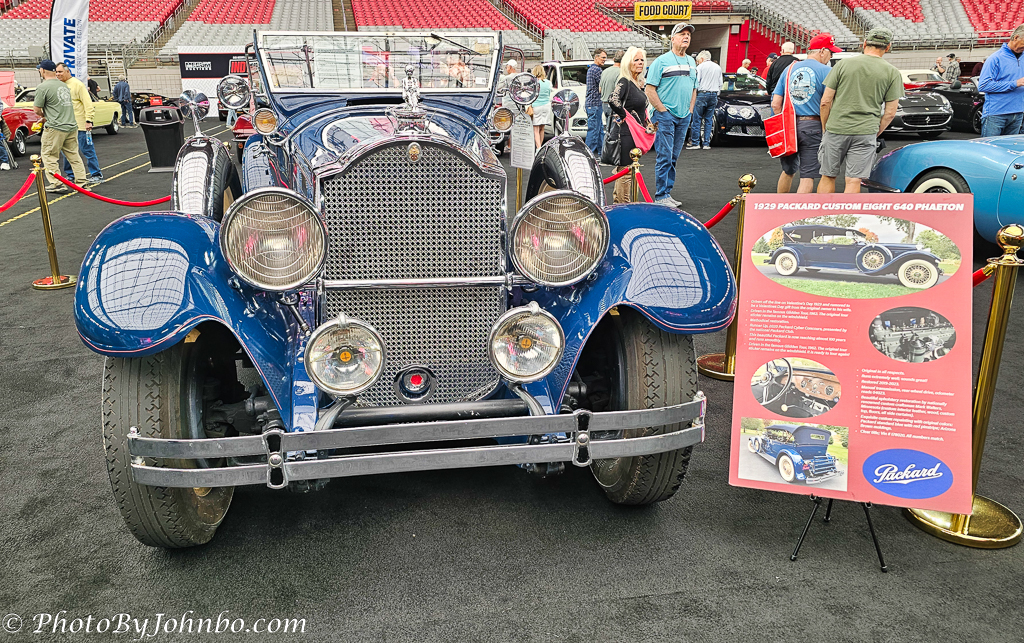
Glendale, Arizona.
For over a decade I visited Barrett-Jackson in Scottsdale. Since we sold the winter home, we’ve missed Barrett-Jackson, but our timing was right for attending the March Mecum auction in Glendale, Arizona. This year we spent an afternoon viewing the cars and meeting with a blogger friend who attends the auction daily. Walking through the interior concourse, I saw one of my favorite 1920s-era cars, the venerable Packard. I was so struck by this car, I decided to feature some details of this Packard model design.
The 1929 Packard Custom Eight 640 Phaeton was a luxurious car built by Packard during a time when they were considered one of the top automakers in the world. It featured a powerful and smooth-running L-head straight-eight engine with a displacement of 385 cubic inches (6.3 liters). This engine delivered around 106 horsepower at 3,200 rpm, which was quite impressive for the time. Unfortunately, the closed hood didn’t allow me to capture a view of the power plant.
The Phaeton body style was an open car with convertible features. Unlike a roadster, which typically had two seats, a phaeton could seat four or more passengers. Car companies didn’t build the bodies themselves; instead, they contracted with coachbuilders who specialized in creating custom bodies for high-end vehicles.
A dual-cowl phaeton has a special design element. A raised separation, called a cowl or bulkhead, runs across the car dividing the front and rear passenger compartments. Because of the bulkhead, this vehicle has two bench seats separated by the cowl. The driver and front passenger sit in the front compartment, while the rear passengers have their own space in the back, often, as in this example, with their own folding windshield for additional comfort.
These Packards were expensive cars, costing between $3,200 and $3,875 when new (roughly $50,000 to $60,000 in today’s dollars). Due to their custom nature, the exact number produced is unknown, but they were undoubtedly rare vehicles. The placard with the car’s highlights noted that it rolled off the line on February 14, 1929. The transmission is a 3-speed manual driving the rear wheels. The car was fully restored, and the project was completed in 2023. It sold at the auction on Saturday, the hammer price was $143,000.
The 1920s were the best years for Packard. In the 1950s, the last years of the company were marked by decline. A merger with Studebaker in 1954 didn’t go as planned. With dwindling sales and mounting losses, the Packard brand was finally phased out in 1959. The last Packard automobiles, built in 1958, marked the end of an era for the once-prestigious automaker.
John Steiner




A stunning piece of machinery; back when car building was almost an art form 😃
That is true. I still marvel at the fact that, though expensive in its time at the equivalent of $60K, today, that’s only a slightly above average price for a sedan.
I just adore old cars John! My dad always took me along when he went to car shows 😀
As time goes on, these classic art forms on wheels get fewer and fewer.
I know and it is so sad!
I can understand why this is your favorite!
It is truly a beautiful piece of classic automotive art.
I love the oldies – they had character.
What a gorgeous car! Your description and photos are terrific. I didn’t know about the cowl or the fact that the custom bodies were produced by other companies.
It is, indeed. I could see myself driving such a car in a parade… but at the price, it will never happen. >grin<
Beautiful machines!
She is a beautiful car 😀